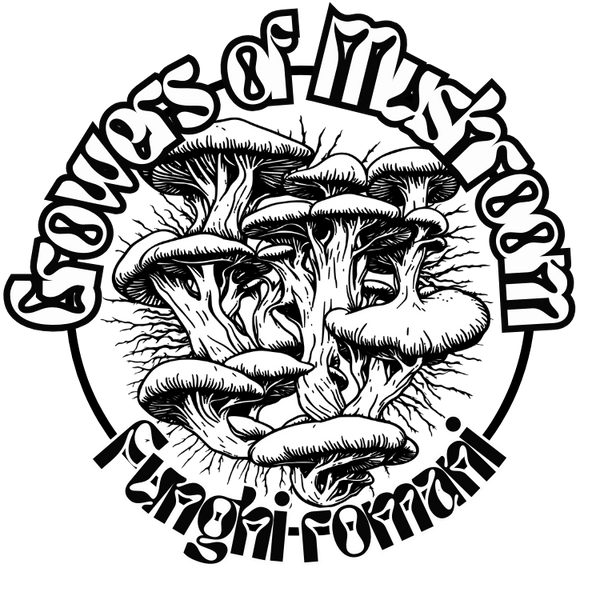
5 Ways to Grow Gourmet and Medicinal Mushrooms at Home
The cultivation of mushrooms is in itself a complex process, where one tries to reproduce and favor those conditions necessary for the development of the biological cycle of the mushrooms. During this process we keep the mycelium alive by transferring it from one substrate to another and allowing it to expand and feed until we judge it mature enough to allow it to produce fruit. In fact, the final part of the biological cycle is represented by the development of the fungus itself, essential for the formation of spores and their release into the environment.
Thanks to the various cultivation techniques tested and developed in recent years, we are able to grow various species of gourmet and medicinal mushrooms with relative simplicity, comfortably at home. Here we will list and give a first description of the various methods for growing mushrooms at home starting from the simplest!
1. Grow kit
These grow kits that are often found on sale are simply the last step before the mushroom sets fruit. It's the easiest way since you rely on the manufacturer to take care of all those more technical and laborious phases necessary to get to this point. These kits are blocks of substrate already colonized by mature mycelium, and ready to bear fruit. At this point the grower only has to worry about providing the ideal conditions for the mycelium so that it can produce the best fruits! Very often these kits are prepared with the simplest species to cultivate, i.e. those less fussy species that adapt more easily to a greater variety of conditions, such as Pleurotus ostreatus or Pleurotus djamor. It remains for the grower to control the amount of oxygen, humidity, temperature and light, thus obtaining the desired mushrooms!

.
2. Grow kit - part 2
Ok, here we are actually talking about the same method as described above, the use of already colonized and mature substrate blocks. The only difference is the greater difficulty related to the species you are trying to cultivate. The greatest difficulty therefore is given by the fact that the species in question need more defined conditions and greater attention to allow them to produce fruit. We therefore consider it a step above the basic kit!

.
3. Spawn to Bulk
At this level we take matters into our own hands. We ourselves will prepare a nice colonized block. To do this we need the mycelium, or the grain spawn, and the production substrate. The grain spawn is nothing more than sterilized cereal colonized by the mycelium of the species we want to cultivate. Warning, make sure it's fresh and live mycelium, not dried! The production substrate, on the other hand, will be a substrate based on sawdust or coconut fibre, sterilized or pasteurised. In conditions of maximum cleanliness, trying to use sterile techniques to avoid contamination, we combine the cereals with the production substrate. From each of these cereals the mycelium will expand which will then colonize the substrate. In addition to promoting colonization, these cereals also provide the necessary nourishment for the mycelium to grow healthy and to produce a good harvest. Once the substrate has been fully colonized, we will finally have our block ready to be put to fruition.

.
4. Prepare your Spawn
The next step is to inoculate the grain spawn yourself. To do this it is necessary to have a culture of mycelium. Mycelium cultures are found mainly in two forms: in liquid culture or on agar petri dishes. Liquid cultures are often the preferred ones because being sold in syringes, they can easily be used to inoculate the grain without needing to use laminar flow hoods or SABs (Still air boxes). However, it is always important to use sterile techniques and to work in sanitized environments and tools. To inoculate your sterile cereal, whether in a jar or in a bag, just inject the liquid culture inside it with a sterile needle. Once the mycelium has colonized the cereal you will have your fresh spawn ready to be used as an inoculum for your favorite production substrate.

.
5. Prepare your own culture
The more advanced level of a grower requires good practice and knowledge of laboratory techniques, and more equipment. The expert grower will therefore dedicate himself to each part of the biological cycle of the mushroom, starting from the spores or from a wild sample. The spores are germinated under sterile conditions on culture media (Agar petri dishes), the mycelium that will form will be selected and transferred several times, until a contaminant-free culture is obtained that produces the desired phenotypic characteristics . Alternatively, it is also possible to start from wild mushrooms. In this case, a tissue sample of the wild mushroom to be cloned is taken, placed on a suitable culture medium on a petri dish, thus obtaining the mycelium of that mushroom. Very probably, as for the spores, it will be necessary to "clean" the culture from contaminants, making as many transfers of the mycelium on new plates as necessary to have a completely clean culture.





1 comment
Utilissimo!